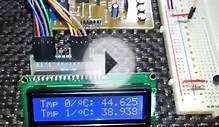AKA Diodes & Integrated Circuit (IC) Temperature Sensors
Semiconductor thermometers are usually produced in the form of ICs, Integrated Circuits. There are many types, sizes and models, but some vendors still provide precision semiconductor diodes to be used as temperature sensors. .
Most are quite small and their fundamental design results from the fact that
Semiconductor diodes have voltage-current characteristics that are temperature sensitive. That means that semiconductor triodes or transistors are also temperature sensitive.
(In truth, the bandgap in a silicon or germanium p-n diode is temperature sensitive; the higher the device’s temperature, the wider the bandgap and the larger the voltage drop across the gap.)
Needless to say, there devices have temperature measurement ranges that are small compared to thermocouples and RTDs, but, they can be quite accurate and inexpensive and very easy to interface with other electronics for display and control.
Literally a whole mini-industry has sprung up around these seemingly simple devices.
Semiconductor technology enables devices to be produced efficiently and cheaply and to have properties designed to easily interface with many other types of semiconductor devices, such as amplifiers, power regulators, buffer output amplifiers and, least we forget, microcomputers.
The major uses are where the temperature range is limited to within a minimum temperature of about -25 °C to a maximum of about 200 °C.
Cost, accuracy, simplicity of interfacing with other circuit elements and size are factors in selecting a device to do a job and meet the both the accuracy and cost budgets.
Check the links below to the various sources of information on semiconductor thermometers or related devices.
Thanks for visiting.
- Semiconductor Thermometer Types, Construction
- Recommended Use Limits and Tolerances
- How Semiconductor Thermometers Work, Lose Calibration and Fail
- Miscellaneous Information
RELATED VIDEO


